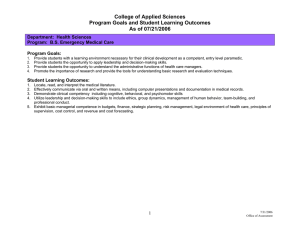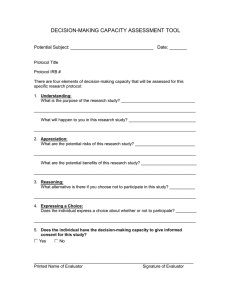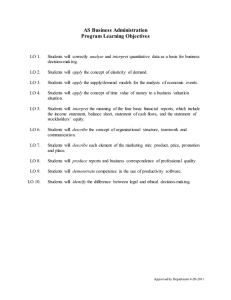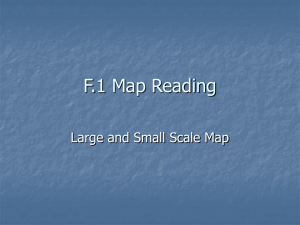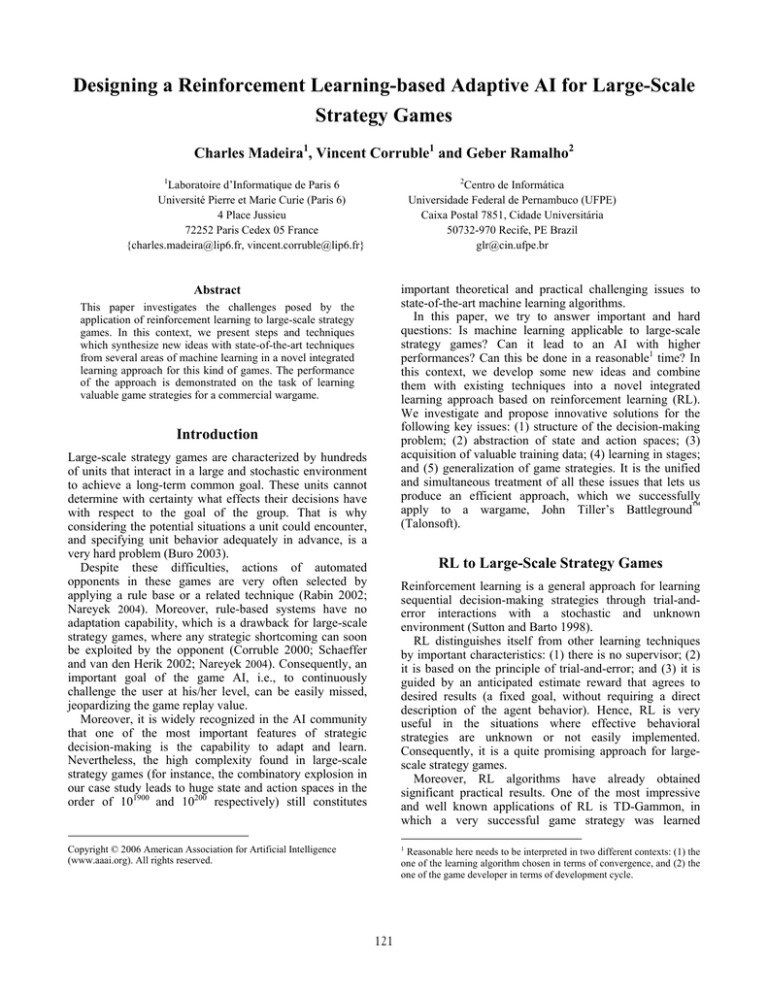
Designing a Reinforcement Learning-based Adaptive AI for Large-Scale
Strategy Games
Charles Madeira1, Vincent Corruble1 and Geber Ramalho2
1
2
Laboratoire d’Informatique de Paris 6
Université Pierre et Marie Curie (Paris 6)
4 Place Jussieu
72252 Paris Cedex 05 France
{charles.madeira@lip6.fr, vincent.corruble@lip6.fr}
Centro de Informática
Universidade Federal de Pernambuco (UFPE)
Caixa Postal 7851, Cidade Universitária
50732-970 Recife, PE Brazil
glr@cin.ufpe.br
important theoretical and practical challenging issues to
state-of-the-art machine learning algorithms.
In this paper, we try to answer important and hard
questions: Is machine learning applicable to large-scale
strategy games? Can it lead to an AI with higher
performances? Can this be done in a reasonable1 time? In
this context, we develop some new ideas and combine
them with existing techniques into a novel integrated
learning approach based on reinforcement learning (RL).
We investigate and propose innovative solutions for the
following key issues: (1) structure of the decision-making
problem; (2) abstraction of state and action spaces; (3)
acquisition of valuable training data; (4) learning in stages;
and (5) generalization of game strategies. It is the unified
and simultaneous treatment of all these issues that lets us
produce an efficient approach, which we successfully
apply to a wargame, John Tiller’s Battleground™
(Talonsoft).
Abstract
This paper investigates the challenges posed by the
application of reinforcement learning to large-scale strategy
games. In this context, we present steps and techniques
which synthesize new ideas with state-of-the-art techniques
from several areas of machine learning in a novel integrated
learning approach for this kind of games. The performance
of the approach is demonstrated on the task of learning
valuable game strategies for a commercial wargame.
Introduction
Large-scale strategy games are characterized by hundreds
of units that interact in a large and stochastic environment
to achieve a long-term common goal. These units cannot
determine with certainty what effects their decisions have
with respect to the goal of the group. That is why
considering the potential situations a unit could encounter,
and specifying unit behavior adequately in advance, is a
very hard problem (Buro 2003).
Despite these difficulties, actions of automated
opponents in these games are very often selected by
applying a rule base or a related technique (Rabin 2002;
Nareyek 2004). Moreover, rule-based systems have no
adaptation capability, which is a drawback for large-scale
strategy games, where any strategic shortcoming can soon
be exploited by the opponent (Corruble 2000; Schaeffer
and van den Herik 2002; Nareyek 2004). Consequently, an
important goal of the game AI, i.e., to continuously
challenge the user at his/her level, can be easily missed,
jeopardizing the game replay value.
Moreover, it is widely recognized in the AI community
that one of the most important features of strategic
decision-making is the capability to adapt and learn.
Nevertheless, the high complexity found in large-scale
strategy games (for instance, the combinatory explosion in
our case study leads to huge state and action spaces in the
order of 101900 and 10200 respectively) still constitutes
RL to Large-Scale Strategy Games
Reinforcement learning is a general approach for learning
sequential decision-making strategies through trial-anderror interactions with a stochastic and unknown
environment (Sutton and Barto 1998).
RL distinguishes itself from other learning techniques
by important characteristics: (1) there is no supervisor; (2)
it is based on the principle of trial-and-error; and (3) it is
guided by an anticipated estimate reward that agrees to
desired results (a fixed goal, without requiring a direct
description of the agent behavior). Hence, RL is very
useful in the situations where effective behavioral
strategies are unknown or not easily implemented.
Consequently, it is a quite promising approach for largescale strategy games.
Moreover, RL algorithms have already obtained
significant practical results. One of the most impressive
and well known applications of RL is TD-Gammon, in
which a very successful game strategy was learned
Copyright © 2006 American Association for Artificial Intelligence
(www.aaai.org). All rights reserved.
1
Reasonable here needs to be interpreted in two different contexts: (1) the
one of the learning algorithm chosen in terms of convergence, and (2) the
one of the game developer in terms of development cycle.
121
automatically for the game of Backgammon (Tesauro
2002).
However, the success of TD-Gammon cannot be easily
repeated in large-scale strategy games. Although the high
level of complexity found in Backgammon (state space in
the order of 1020 and action space in the order of 102), it is
dwarfed by the one found in the kind of games we are
interested in here.
In order to illustrate the complexity of a large-scale
strategy game, we take a look at our case study:
Battleground™. Battleground™ is a turn-based commercial
wargame that simulates a confrontation between two
armies at historical battlefields. Its scenarios model units
which move on maps composed of hexagons.
Taking into account a simple scenario of Battleground™,
the allied army contains 128 units, the enemy army
contains 102 units, and 3 objectives are placed on a map
composed of 700 hexagons. The combinatory explosion of
the possible situations leads to a huge state space in the
order of 101887. Moreover, if we consider this decisionmaking problem with a centralized perspective, the
complexity grows exponentially with the number of units
involved (Guestrin et al. 2003). Then, this would lead to a
maneuver action space in the order of 10231 and a combat
action space in the order of 10131 for the allied army.
In order to tackle the curse of dimensionality, our
approach, detailed in the next section, follows a direction
adopted in the last years by the field of RL: the use of prior
domain knowledge may allow much faster learning.
terrain is especially useful because tactical locations can be
determined, such as ideal locations for scouting parties,
best line of sight/fire and also the ability to hide troops and
equipment.
Following these ideas, we designed an algorithm for the
automatic generation of abstracted state and action spaces,
as detailed in (Madeira, Corruble, and Ramalho 2005).
Acquiring Valuable Training Data
Our approach generates experience for learning by using a
“hand-made” (non-learning) AI agent to train against. For
our application, a basic AI agent composed mainly of
tactical (or low-level) actions can be built relatively easily,
designed by using techniques such as rule bases. Then, we
let our system (called the learning AI) play and learn
against this pre-built AI (called bootstrap AI). After
learning against the bootstrap AI, the self-play option can
be considered to further improve the learnt strategy.
Learning in Stages
Learning a good strategy for all levels of a hierarchy at
once remains a very complex task to tackle as a result of
the extremely high dependence of the global performance
on the performances of individual levels of the hierarchy
(Stone 2000). For this reason, we use a bootstrap
mechanism by again taking advantage of the hierarchical
decomposition. This mechanism articulates some form of
incremental learning by letting the learning AI take only
partial control over its hierarchy, where the bootstrap AI
takes control of the subordinate levels of the learning AI
hierarchy, in addition to the full control of the opponent
hierarchy. This allows cooperation between the learning
AI and the bootstrap AI, leaving only a small part of the
decision-making process to be learnt at any given time.
This is an important point of our approach because it
allows learning in stages (top-down approach) with
increasingly refined levels of specificity and detail.
An Integrated Learning Approach for LargeScale Strategy Games
Structuring the Decision-Making Problem
From an agent perspective, a decision-making architecture
may be organized as an agent society where agents have
specific roles to play. Given that societies in large-scale
strategy games are often armies, we can easily identify that
a hierarchical structure of command and control is a
natural organization where the agents’ decision-making is
carried out at several levels, ranging from strategic to
tactical decisions.
In this context, different levels of the hierarchy may
correspond to different granularities of the state and action
spaces in order to decrease the learning complexity for
each specialized agent subgroup. Moreover, hierarchies
can provide coordination mechanisms where agents
interact in order to work as a team.
Generalizing Game Strategies
Finally, our approach uses parameterized function
approximators in order to generalize between similar
situations and actions. This is crucial to be able to make
interesting decisions in the situations which one has never
encountered before. However, function approximation in
the context of RL is more difficult than in the classical
supervised learning setting (Ratitch and Precup 2002) and
still present important difficulties when applied in complex
domains. Despite this, in practice, the use of function
approximators has already proven quite successful
(Tesauro 2002).
Abstracting State and Action Spaces
In strategic and tactical levels of operation, spatial
information provides the most important context for
analysis of sensed data (Grindle et al. 2004). This crucial
information can be obtained by techniques of abstraction
or terrain analysis. In this context, understanding the
Experiments and Results
We used a complex scenario of Battleground™,
representing a battle between French and Russian armies in
1812. We configured our system (the learning AI) to
122
control the decision-making at high level of the French
army giving strategic orders to a subordinate level, while
the Battleground™ existing AI (the bootstrap AI) (1)
controls the Russian army, and (2) follows French orders
flowing down the hierarchy from the level controlled by
the learning AI. Commander’s decision-making is
implemented in a fully distributed fashion, allowing the
use of different techniques for coordinating the agents.
We implemented the gradient-descent Sarsa(λ)
algorithm (Sutton and Barto 1998) combined with a
function approximator (multilayer artificial neural network
(NN) with back-propagation of errors). We used two fullyconnected cascade feed-forward architectures with 80hidden neurons as NN: (1) NN LAI 1: a unique neural
network with 64 inputs (abstracted state representation)
and 45 outputs (abstracted action space); and (2) NN LAI
45: 45 neural networks with 64 inputs and 1 output each (a
neural network for each action).
The reward function is computed as the change in the
game score between the previous and current game turns
for all commanders.
The application of our terrain analysis algorithm
generated 11 key locations and 11 zones on the map.
Moreover, an abstracted state representation composed of
64 continuous variables was built (see Figure 1). After
abstraction, the complexity of the scenario was reduced to
a state space in the order of 1082, and an action space in the
order of 105 at corps decision-making level.
Evaluation Results of the Learning AI (LAI)
300
Random
NN LAI 1
Bootstrap AI
NN LAI 45
A Human Player
200
9500
10000
-200
9000
8500
8000
7500
7000
6500
6000
5500
5000
4500
4000
3500
3000
2500
2000
1500
1000
0
0
-100
500
Average Score (50:1)
100
-300
-400
-500
-600
Number of Learning Games
Figure 2.Progress evaluation of the function approximators
Conclusion and Future Work
In this paper, we introduced a novel integrated learning
approach based on RL for large-scale strategy games. Our
approach synthesizes new ideas with state-of-the-art
techniques from several areas of machine learning.
We evaluated the approach on the Battleground™
simulator and obtained very satisfactory results since it
outperformed by far the commercial AI. Furthermore, we
demonstrated that RL can work in a reasonable time when
combined with other techniques. We consider therefore
our approach to be a promising direction in the pursuit of
high quality game AI for large-scale strategy games.
References
Buro, M. 2003. Real-Time Strategy Games: A new AI Research
Challenge. In Proceedings of the Eighteenth International Joint
Conference on Artificial Intelligence, Acapulco, Mexico, 2003.
Corruble V. 2000. AI approaches to developing strategies for
wargame type simulations. AAAI Fall Symposium on Simulating
Human Agents. Cape Cod, USA.
Grindle, C., Lewis, M., Glinton, R., Giampapa, J., Owens, S., and
Sycara, K. 2004. Automating Terrain Analysis: Algorithms for
Intelligence Preparation of the Battlefield. In Proceedings of the
Human Factors and Ergonomics Society, Santa Monica, CA.
Guestrin, C., Koller, D., Gearhart, C., and Kanodia, N. 2003.
Generalizing Plans to New Environments in Relational MDPs. In
Proceedings of the Eighteenth International Joint Conference on
Artificial Intelligence, Acapulco, Mexico.
Madeira, C., Corruble, V., and Ramalho, G. 2005. Generating
Adequate Representations for Learning from Interaction in
Complex Multiagent Simulations. In Proceedings of the
IEEE/WIC/ACM International Joint Conference on Intelligent
Agent Technology, 512-515, Compiègne, France.
Nareyek, A. 2004. AI in Computer Games. ACM Queue, 1(10).
Rabin, S. 2002. AI Game Programming Wisdom. Charles River.
Ratitch, B., and Precup, D. 2002. Characterizing Markov
Decision Process. In Proceedings of the Thirteenth European
Conference on Machine Learning, Finland.
Schaeffer, J., and van den Herik, H. 2002. Games, computers,
and artificial intelligence. Artificial Intelligence, 134(1-2):1-8.
Stone, P. 2000. Layered Learning in Multi-agent Systems: A
Winning Approach to Robotic Soccer. MIT Press.
Sutton, R., and Barto, A. 1998. Reinforcement Learning: An
Introduction. Cambridge, MA: MIT Press.
Tesauro, G. 2002. Programming backgammon using self-teaching
neural nets. Artificial Intelligence, 134(1-2), 181-199.
Figure 1. Abstraction of state and action spaces
Each LAI architecture implemented was trained for 10000
games with learning parameter decaying of 10% every 250
episodes and constant exploration rate. We compared our
learning agents with other architectures (random agents,
the commercial agents, and a human – the first author of
this paper – who we consider as an average player), and
evaluated all architectures by playing against the
commercial agents (Russian army). All architectures used
the same configuration as the learning agents, i.e.,
controlling French corps commanders.
The results indicate that our system has made interesting
progress after only a few thousand learning games with an
important improvement in average score (see Figure 2).
The results place our learning agents close to the average
score of the human player.
123

